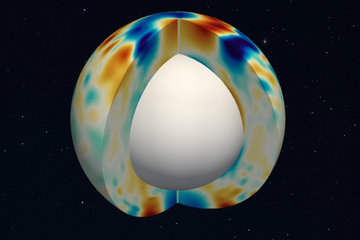All genres
1.
Journal Article
3D radiative MHD simulations of starspots: II. Large-scale structure. Astronomy and Astrophysics 693, p. A264 (2025)
2.
Journal Article
The Sun's differential rotation is controlled by high-latitude baroclinically unstable inertial modes. Science Advances 10, p. eadk5643 (2024)
3.
Journal Article
The Sun's differential rotation is controlled by high-latitude baroclinically unstable inertial modes. Science Advances 10, p. eadk5643 (2024)
4.
Journal Article
Small-scale dynamo in cool stars. III. Changes in the photospheres of F3V to M0V stars. Astronomy and Astrophysics 681, p. A32 (2024)
5.
Journal Article
Small-scale dynamo in cool stars. III. Changes in the photospheres of F3V to M0V stars. Astronomy and Astrophysics 681, p. A32 (2024)
6.
Journal Article
Non-thermal broadening of coronal lines in a 3D MHD loop model. Monthly Notices of the Royal Astronomical Society (2024)
7.
Journal Article
Non-thermal broadening of coronal lines in a 3D MHD loop model. Monthly Notices of the Royal Astronomical Society 530, pp. 2361 - 2377 (2024)
8.
Journal Article
The mean solar butterfly diagram and poloidal field generation rate at the surface of the Sun. Astronomy and Astrophysics 691, p. A9 (2024)
9.
Journal Article
How well does surface magnetism represent deep Sun-like star dynamo action? Astronomy and Astrophysics 684, p. A92 (2024)
10.
Journal Article
How well does surface magnetism represent deep Sun-like star dynamo action? ASTRONOMY & ASTROPHYSICS (2024)
11.
Journal Article
The influence of small bipolar magnetic regions on basic solar quantities. Astronomy and Astrophysics 683, p. A48 (2024)
12.
Journal Article
The influence of small bipolar magnetic regions on basic solar quantities. Astronomy and Astrophysics 683, p. A48 (2024)
13.
Journal Article
Low-latitude Magnetic Flux Emergence on Rapidly Rotating Solar-type Stars. The Astrophysical Journal 976, p. 215 (2024)
14.
Journal Article
Magnetic origin of the discrepancy between stellar limb-darkening models and observations. Nature Astronomy (2024)
15.
Journal Article
Magnetic origin of the discrepancy between stellar limb-darkening models and observations. Nature Astronomy 8, pp. 929 - 937 (2024)
16.
Journal Article
Mg II h&k spectra of an enhanced network region simulated with the MURaM-ChE code: Results using 1.5D synthesis. Astronomy and Astrophysics 692, p. A6 (2024)
17.
Journal Article
A flux-independent increase in outflows prior to the emergence of active regions on the Sun. Monthly Notices of the Royal Astronomical Society 533, pp. 225 - 243 (2024)
18.
Journal Article
Testing MURaM and MPS-ATLAS against the quiet solar spectrum. Astronomy and Astrophysics 681, p. A81 (2024)
19.
Journal Article
Three-dimensional non-kinematic simulation of the post-emergence evolution of bipolar magnetic regions and the Babcock-Leighton dynamo of the Sun. Astronomy and Astrophysics 670, p. A101 (2023)
20.
Journal Article
Swirls in the solar corona. Astronomy and Astrophysics 675, p. A94 (2023)











